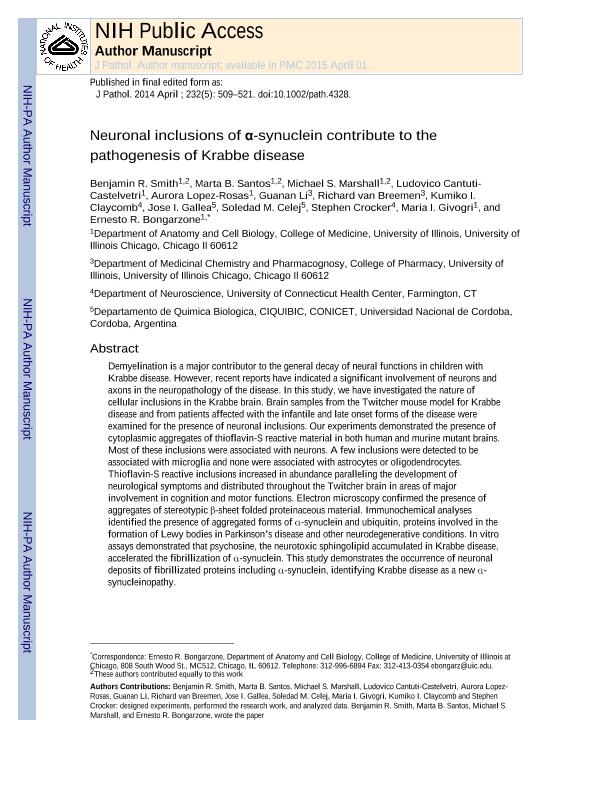Artículo
Neuronal inclusions of α-synuclein contribute to the pathogenesis of Krabbe disease
Smith, Benjamin R.; Santos, Marta B.; Marshall, Michael S.; Cantuti-Castelvetri, Ludovico; Lopez-Rosas, Aurora; Li, Guannan; Van Breemen, Richard B.; Claycomb, Kumiko I.; Gallea, Jose Ignacio ; Celej, Maria Soledad
; Celej, Maria Soledad ; Crocker, Stephen J.; Givogri, Maria I.; Bongarzone, Ernesto R.
; Crocker, Stephen J.; Givogri, Maria I.; Bongarzone, Ernesto R.
 ; Celej, Maria Soledad
; Celej, Maria Soledad ; Crocker, Stephen J.; Givogri, Maria I.; Bongarzone, Ernesto R.
; Crocker, Stephen J.; Givogri, Maria I.; Bongarzone, Ernesto R.
Fecha de publicación:
04/2014
Editorial:
John Wiley & Sons Ltd
Revista:
Journal of Pathology
ISSN:
0022-3417
e-ISSN:
1096-9896
Idioma:
Inglés
Tipo de recurso:
Artículo publicado
Clasificación temática:
Resumen
Demyelination is a major contributor to the general decay of neural functions in children with Krabbe disease. However, recent reports have indicated a significant involvement of neurons and axons in the neuropathology of the disease. In this study, we have investigated the nature of cellular inclusions in the Krabbe brain. Brain samples from the twitcher mouse model for Krabbe disease and from patients affected with the infantile and late-onset forms of the disease were examined for the presence of neuronal inclusions. Our experiments demonstrated the presence of cytoplasmic aggregates of thioflavin-S-reactive material in both human and murine mutant brains. Most of these inclusions were associated with neurons. A few inclusions were detected to be associated with microglia and none were associated with astrocytes or oligodendrocytes. Thioflavin-S-reactive inclusions increased in abundance, paralleling the development of neurological symptoms, and distributed throughout the twitcher brain in areas of major involvement in cognition and motor functions. Electron microscopy confirmed the presence of aggregates of stereotypic β-sheet folded proteinaceous material. Immunochemical analyses identified the presence of aggregated forms of α-synuclein and ubiquitin, proteins involved in the formation of Lewy bodies in Parkinson's disease and other neurodegenerative conditions. In vitro assays demonstrated that psychosine, the neurotoxic sphingolipid accumulated in Krabbe disease, accelerated the fibrillization of α-synuclein. This study demonstrates the occurrence of neuronal deposits of fibrillized proteins including α-synuclein, identifying Krabbe disease as a new α-synucleinopathy. Copyright © 2014 Pathological Society of Great Britain and Ireland.
Archivos asociados
Licencia
Identificadores
Colecciones
Articulos(CIQUIBIC)
Articulos de CENTRO DE INVEST.EN QCA.BIOL.DE CORDOBA (P)
Articulos de CENTRO DE INVEST.EN QCA.BIOL.DE CORDOBA (P)
Citación
Smith, Benjamin R.; Santos, Marta B.; Marshall, Michael S.; Cantuti-Castelvetri, Ludovico; Lopez-Rosas, Aurora; et al.; Neuronal inclusions of α-synuclein contribute to the pathogenesis of Krabbe disease; John Wiley & Sons Ltd; Journal of Pathology; 232; 5; 4-2014; 509-521
Compartir
Altmétricas



